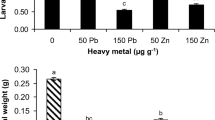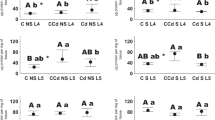Abstract
Tanytarsus dissimilis (Johannsen) was exposed to four heavy metals. Static exposure began during embryogenesis and continued through hatching and larval development to the 2nd or 3rd instar. The LC50 concentrations for cadmium, copper, and zinc were 3.8, 16.3, and 36.8μg/l, respectively. The LC50 for lead was 258μg/1. Growth was not reduced at exposure concentrations less than the LC50.
The LC50 concentrations obtained in this insect exposure are as much as 1,600 times lower than other insect exposures reported in the literature. This is probably due to a combination of exposure of this insect during important life cycle events and species-specificity.
Similar content being viewed by others
References
American Public Health Association: Standard methods for the examination of water and wastewater. 13th ed. New York, NY (1971).
Biesinger, K. E., and G. M. Christensen: Effects of various metals on survival, growth, reproduction, and metabolism ofDaphnia magna. J. Fish. Res. Board Can.29, 1691 (1972).
Cherry, D. S., R. K. Guthrie, F. F. Sherberger, and S. R. Larrick: The influence of coal ash and thermal discharges upon the distribution and bioaccumulation of aquatic invertebrates. Hydrobiologia62, 257 (1979).
Clubb, R. W., A. R. Gaufin, and J. L. Lords: Acute cadmium toxicity studies upon nine species of aquatic insects. Environ. Res.9, 332 (1975).
Johannsen, O. A.: Aquatic Diptera. Part IV. Chironomidae: Subfamily Chironominae. Cornell Univ., Agr. Exp. Stat. Memoir210, 3 (1937).
Nebeker, A. V.: Temperature requirements and life cycle of the midgeTanytarsus dissimilis (Diptera: Chironomidae). J. Kans. Entomol. Soc.46, 160 (1973).
Nehring, R. B.: Aquatic insects as biological monitors of heavy metal pollution. Bull. Environ. Contam. Toxicol.15, 147 (1976).
Rehwoldt, R., L. Lasko, C. Shaw, and E. Wirhowski: The acute toxicity of some heavy metal ions toward benthic organisms. Bull. Environ. Contam. Toxicol.10, 291 (1973).
Spehar, R. L., R. L. Anderson, and J. T. Fiandt: Toxicity and bioaccumulation of cadmium and lead in aquatic invertebrates. Environ. Pollut.15, 195 (1978).
Surber, E. W.:Cricotopus bicinctus, a midgefly resistant to electroplating wastes. Trans. Am. Fish. Soc.88, 111 (1959).
Thorp, V. J., and P. S. Lake: Toxicity bioassays of cadmium on selected freshwater invertebrates and the interaction of cadmium and zinc on the freshwater shrimpParatya tasmaniensis Riek. Aust. J. Mar. Freshwater Res.25, 97 (1974).
Warnick, S. L., and H. L. Bell: The acute toxicity of some heavy metals to different species of aquatic insects. J. Water Pollut. Control Fed.41, 280 (1969).
Author information
Authors and Affiliations
Rights and permissions
About this article
Cite this article
Anderson, R.L., Walbridge, C.T. & Fiandt, J.T. Survival and growth ofTanytarsus dissimilis (Chironomidae) exposed to copper, cadmium, zinc, and lead. Arch. Environ. Contam. Toxicol. 9, 329–335 (1980). https://doi.org/10.1007/BF01057412
Received:
Accepted:
Issue Date:
DOI: https://doi.org/10.1007/BF01057412




